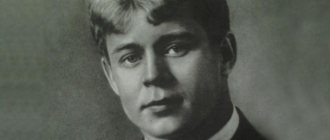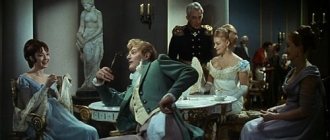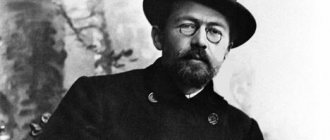Why did Dolly, when getting married, know nothing about family life? What stopped Karenin from dueling? Could Vronsky marry Anna and become the legal father of his children?
The Mystery of Dolly's Innocence
Anna Karenina and Dolly Oblonskaya. Illustration by Mikhail Shcheglov for Leo Tolstoy’s novel “Anna Karenina”. 1914
After a scandal over Stiva's betrayal, Anna comes to the Oblonskys' house to reconcile the spouses. Depressed by the situation, Dolly justifies her refusal to forgive her husband:
“If you please,” she suddenly said. - But I'll tell you first. You know how I got married. With maman's upbringing, I was not only innocent, but I was stupid. I didn't know anything. They say, I know, husbands tell their wives their former lives, but Stiva...” she corrected herself, “Stepan Arkadyevich didn’t tell me anything.” You won’t believe it, but until now I thought that I was the only woman he knew. I lived like this for eight years. You must understand that not only did I not suspect infidelity, but that I considered it impossible, and then, imagine, with such concepts suddenly recognizing all the horror, all the disgusting... You understand me. To be completely confident in your happiness, and suddenly..."
Why was Daria Oblonskaya so naive - not only before marriage, but also after? During that era, sex education for men and women was very different. In the traditional noble family of the first half of the 19th century, the question of the theory of sexual relations was not raised either by teachers, much less by parents, who, as a rule, distanced themselves from their children. It was customary to raise a “morally pure” person, so teenage interest in sex was suppressed in every possible way: discussion of bodily changes during puberty was not encouraged, communication with the opposite sex was limited, etc. These prohibitions mainly concerned girls. Before marriage, they recognized the only possible only platonic love, which they knew about thanks to fiction. Almost every young lady walked down the aisle, having no idea about sex and knowing only that “the only difference between her and her groom is that he has facial hair and she doesn’t; that he sews a dress from a tailor, and she from a seamstress...”
The situation was completely different with the young men. Answers to many questions were obtained in a practical way. Before the abolition of serfdom, a serf girl was assigned to a young man (her marital status was not taken into account when choosing - only experience and health were important), later the responsibility for “sexual education” passed to the servants and servants. Often fathers took their sons to brothels, and at a fairly early age. According to the “Gender Census of Students,” conducted in 1904, the majority of respondents (69%) had their first acquaintance with a woman at the age of 14–17 years.
Anna Karenina
Tatyana Samoilova and Svetlana Khodchenkova.
Photo: Stills from films about Anna Karenina The role of Anna Karenina, a kind and well-fed woman with dark curls, went to... Svetlana Khodchenkova (pictured is a still from the film “8 First Dates”). Why not? The plot of the new project is reminiscent of “Gangster Petersburg”, as it revolves around the alcove, criminal and political affairs of the St. Petersburg elite.
In this interpretation, Khodchenkova plays a socialite and the wife of the future governor of St. Petersburg, Alexei Karenin. In the novel, Anna was about 25 - 28 years old (20 years younger than her husband), Svetlana was significantly older - 38. But in the Soviet film, the visual correspondence was higher: brunette Tatyana Samoilova was 32 years old at the time of filming.
Mystery of Rome
Scene at the races. Illustration by Alexander Samokhvalov for Leo Tolstoy’s novel “Anna Karenina”. 1952–1953 © Alexander Samokhvalov / Nauka Publishing House
After Vronsky’s horse broke its back and fell along with its rider, the stunned spectators repeated the phrase several times:
“The only thing missing is a circus with lions.”
“Anna Karenina” is not only a love story, but also a poignant social novel. Tolstoy said: “Our civilization is also heading towards its decline, like the ancient civilization...”. While people in Russian villages were dying of hunger, various types of entertainment establishments flourished in the cities. Tolstoy repeatedly compares Russia in the second half of the 19th century with Rome in the era of decline. Thus, Karenin calls the Krasnoselsk races mentioned above “a cruel spectacle,” and Vronsky appears before readers as one of the last “gladiators.” A horse that wins a race is called a gladiator, and one of the spectators says: “If I were a Roman, I would not miss a single circus.” Anna communicates with Sappho, a socialite, and Vronsky attends “Athenian evenings.”
Alexey Vronsky
Vasily Lanovoi and Roman Vasiliev.
Photo: Stills from films about Anna Karenina/Roman Vasiliev’s Facebook The image of the heartthrob officer Alexei Kirillovich Vronsky (23 years old) was entrusted to the young Roman Vasiliev (26 years old), whose track record includes only a couple of small roles in TV series and voice acting.
In "Anna K." Vronsky is the heir to the aluminum empire, with whom the wife of St. Petersburg tycoon Karenin falls in love. Well, in 1967, the elegant Vasily Lanovoi performed the role of Vronsky’s adjutant.
Alexey Karenin
Nikolai Gritsenko and Fyodor Bondarchuk.
Photo: Stills from films about Anna Karenina Who is the most impressive, stylish and often plays officials in our cinema? Of course, Fyodor Bondarchuk (pictured in the film “Sleepers”). The actor is almost the same age as the literary hero: the high-ranking statesman Karenin was 48, Bondarchuk is now 54. His hero in the modern television adaptation of the novel is involved in politics.
In the Soviet version, the role of the cuckolded dignitary was played by one of the leading artists of the Vakhtangov Theater Nikolai Gritsenko.
The secret of the Karenin children
Alexey Karenin with newborn Anna. Illustration by Mikhail Shcheglov for Leo Tolstoy’s novel “Anna Karenina”. 1914 Antique book store “Russian Bibliophile”
Anna is not ready for a divorce, and Vronsky asks Dolly for help. His main argument in favor of divorce is children:
“My daughter is legally not my daughter, but Karenina. I don't want this deception! - he said with an energetic gesture of denial and looked gloomily and questioningly at Daria Alexandrovna. She didn't answer and just looked at him. He continued: “And tomorrow a son will be born, my son, and by law he is Karenin, he is not the heir to either my name or my fortune, and no matter how happy we are in the family and no matter how many children we have, between me and there is no connection between them. They are Karenins."
In the legislation of the 19th century, as today, there was a so-called presumption of legality, according to which a baby born to parents who were legally married (like Anna Karenina and her husband) was indicated in the metric as legitimate. The child was considered legitimate until the contrary was proven through special church or judicial proceedings. That is why little Anya received the surname of her “father by law.”
If he wanted, Karenin could begin the process of recognizing the girl’s “aligned” wife as illegal, but there was little chance of winning the case. The only argument in favor of the plaintiff was the impossibility of his meetings with Anna Arkadyevna at the time when the child was conceived (according to the laws of that time - 306 days). This could be proven provided that the Karenins lived all this time in different cities or if one of the spouses was under special supervision (in a hospital or prison). But the Karenins lived together, which means that little Anya in this case had no chance of becoming Vronskaya. Vronsky's only opportunity to legitimize his daughter was the Karenins' divorce. But, unfortunately, the situation with him was no less difficult.
The only reason for the divorce of Anna and Alexey Alexandrovich could be adultery: Russian legislation of the second half of the 19th - early 20th centuries called this “an insult to the sanctity of marriage” and the fact of “sexual relations of one of the spouses with a stranger, no matter whether married or free.” After Anna’s illness, which almost led to death, Karenin forgave her for her betrayal in a Christian manner and agreed to let her go, falsifying the divorce, that is, taking the blame for adultery upon himself. Thus, he allowed Anna to maintain her reputation, later marry Vronsky and give his surname to little Anna (after adoption). This is precisely the outcome that Vronsky hoped for. But Karenina herself, and then her husband, refused such a solution to the problem.
Karenina could only break off relations with her husband by taking the blame upon herself. But in this case, the birth of little Anya would be the result of a criminal relationship, and such children could not be legitimized or adopted. Having confirmed her betrayal in court, Karenina would have doomed herself to lifelong celibacy (this was only lifted in May 1904), would not be able to officially marry Vronsky, and their future children would be considered illegitimate and would not have the right to bear their father’s surname.
Daria Oblonskaya
Iya Savvina and Yulia Alexandrova.
Photo: Stills from films about Anna Karenina Stiva’s wife, Dolly Oblonskaya, will be played by the wife of director Zhora Kryzhovnikov, Yulia Alexandrova (pictured in the film “(NOT) the Ideal Man”). She got the image of a 33-year-old young lady, exhausted by six children and lack of money. Yulia herself is 39, she has one child. In the Soviet film, Iya Savvina played this role brilliantly.
Dolly Oblonskaya image and characteristics
Dolly Oblonskaya image and characteristics according to plan
1. General characteristics . Daria Alexandrovna Oblonskaya (Dolly) is one of the female heroines of L. N. Tolstoy’s novel “Anna Karenina”.
This is the wife of Stepan Arkadyevich, a loving and caring mother of six children.
At the beginning of the work, a tragedy occurs in the life of Daria Alexandrovna: she learns about her husband’s betrayal.
Under the influence of Anna Karenina, the woman forgives her husband, but from that time on a noticeable crack appears in their relationship.
2. Appearance . In the past, Daria Alexandrovna was a very beautiful woman. Frequent childbirth and family worries took a noticeable toll on her. The mother of many children has lost weight, her face has become haggard, and her once “thick and beautiful” hair has thinned.
The former beauty can be recognized when her face lights up with a “mocking smile.” Her husband’s betrayal dealt another blow to Dolly’s appearance: “frightened eyes” stand out sharply on her lost and suffering face.
3. Attitude towards husband and children. Daria Alexandrovna received a home education and did not know life at all. When she was given in marriage, she was absolutely convinced of the sanctity of marriage. Eight years of happy married life only confirmed the woman in her naive conviction.
Daria Alexandrovna loves Stepan Arkadyevich very much, which is why she takes his relationship with the governess so close to her heart. She is even afraid to admit to herself that this love will not allow her to leave her husband. Dolly enters into a struggle with hatred for the man who cruelly deceived her. She very accurately expresses the intractability of the problem in a conversation with Anna: “I love my past love for him...”.
Another obstacle to divorce for Daria Alexandrovna is caring for children. She believes that after what happened they “died.” On the one hand, Dolly does not want to leave her children without a father; on the other hand, he fears for their morality under the influence of a depraved person. At the same time, constant child care allows a woman to forget about her misfortune for a while.
Anna Karenina very correctly guesses which argument will most influence Dolly to forgive her husband: “he is ashamed of the children.” Daria Alexandrovna readily agrees to reconcile with her husband. To do this, she only needed the participation of a loved one. But a bitter aftertaste remains in her soul. Reconciliation turns out to be fragile.
Having learned the deception, Dolly constantly experiences suspicions and pangs of jealousy. Having already given birth to her sixth child, she understands that beauty and attractiveness have long been lost. Women still like the strong and healthy Stepan Arkadyevich and may well experience a new hobby.
4. The role in the work and the meaning of the image . Daria Alexandrovna Oblonskaya appears in the novel as the keeper of the hearth. Turning a blind eye to her husband's infidelity, she strives to save the family and fulfill the main (according to L.N. Tolstoy) female function - to give birth and raise children.
Having survived the misfortune, Dolly does not want her sister to repeat her fate. Knowing how she feels about Kitty Levin, she does her best to bring them closer together. This desire unites her with her husband: Stepan Arkadyevich, for his part, also persuades his best friend to explain himself to his beloved girl. The marriage between Kitty and Levin (the ideal family) is a huge credit to the Oblonskys
Stepan Oblonsky
Yuri Yakovlev and Gosha Kutsenko.
Photo: Stills from films about Anna Karenina The role of Stiva, Anna Karenina’s brother, was entrusted to the unsinkable Gosha Kutsenko (pictured in the film “Courier from Paradise”). Stepan Arkadyevich Oblonsky is one of the most important characters in the novel, copied by Tolstoy from his friend, landowner and official Vasily Perfilyev. He is 34 years old and he is like Fr.
Whether Kutsenko, who is also exactly 20 years older than Stiva, is handsome is up to you to decide. In the film adaptation of Zarkhi, this image was embodied by Yuri Yakovlev, who certainly cannot be called ugly.
Konstantin Levin
Boris Goldaev and Yuri Borisov.
Photo: Stills from films about Anna Karenina The image of Levin will be embodied by the incredibly relevant now Yuri Borisov (pictured in the series “Peace! Friendship! Chewing Gum!”), two films with whom recently thundered in Cannes. According to the book, his character, an idealistic landowner with a troubled conscience, is 32 years old, Borisov himself is 28. In the old “Anna Karenina”, Boris Goldaev was responsible for the image of Levin.





